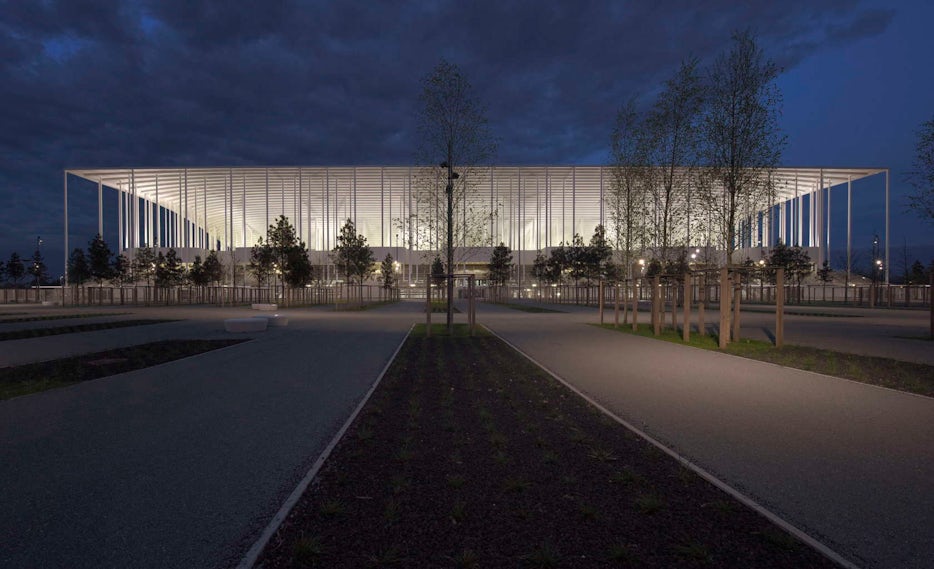Updated by Paul Keskeys, June 10th 2016.
Today marks a big moment for soccer fans, as Euro 2016 kicks off in Paris with the showpiece match between the hosts and Romania at the Stade de France. However, for the most stunning arena of the event, architectural enthusiasts must look further south, to the port city of Bordeaux.
When it comes to stadium design, Jacques Herzog and Pierre de Meuron have got history. 10 years ago, the luminous exterior of the Allianz Arena lit up the night sky for the first time, a bold sporting beacon for Munich that formed a vibrant venue for the World Cup in 2006. This was followed by even more monumental exploits in sport-as-placemaking, as the Bird’s Nest Stadium in Beijing was unveiled to international acclaim in 2008. These arenas were, in their own way, grand architectural statements: they were designed as singular objects isolated from the surrounding context, primed to induce awe, charged with representing the burgeoning cultural prominence of their respective cities.

© vigouroux_perspective
The appearance of Herzog and de Meuron’s latest stadium, then, might come as a surprise. In comparison to that exuberant pair of set-piece structures, the Nouveau Stade Bordeaux is an exhibition in understatement — as understated as a 42,000-capacity stadium can hope to be, at least. Set to host Wales vs. Slovakia tomorrow, the arena will welcome fans through a forest of pearly white columns, shading them with a canopy of stands stripped back to their essential elements.
The building’s exterior clearly expresses the bowl-like form often concealed deep within the heart of conventional stadium designs of previous decades. Herzog and de Meuron have stripped away the architectural flesh to reveal the skeletal structure beneath, comprising just three primary elements: a monumental staircase wrapping around the base of the stadium, a ribbon of catering facilities weaving between slender white columns, and an elegant canopy whose ribbed surface reads as a mirror image of the steps below.

© vigouroux_perspective
While the elevations have been pared down to the extreme, make no mistake: the form and aesthetics of this arena possess an undeniably iconic quality. Its simplicity only serves to emphasize elements that might otherwise blend into the background — the abundance of columns, for example, is transformed into a spectacle, particularly at night when powerful up-lights illuminate the underside of the bowl. The effect is reminiscent of Icaro de Castro Mello’s Estadio Nacional in Brasília, though the pillars of Herzog and de Meuron’s structure are even more refined: perhaps they have been taking notes from the Japanese connoisseurs of gleaming white modernism, SANAA.

© vigouroux_perspective
Moving inside, things are no less minimal. 42,000 seats are colored in one of three muted shades — gray, mid-gray, and white — offering subtle visual variations across the terraces. Each seat has an extraordinary amount of legroom — the sporting equivalent of business class on an airplane — which means that the two-tiered terraces are fairly shallow in pitch, which may ultimately affect the atmosphere on match days — older stadiums with steeper stands are generally considered to engender a more cauldron-like atmosphere (see the Estadio Mestalla in Valencia), but for the Nouveau Stade Bordeaux, judgment must be reserved until kickoff time this Saturday.

© Iwan Baan
Overhead, the stands are sheltered by an impossibly thin roof that reads as a seamless plane floating above the seats. In contrast to the exterior, this canopy is cantilevered off the back of the stands to provide an entirely column free space, offering perfectly unobstructed views of the field. This configuration means the stadium is also optimized for a variety of events besides sports: a huge music concert is envisaged in the firm’s cinematic trailer for the building, and corporate events will also be catered for with spacious hospitality suites located between the lower and upper tiers.
Nouveau Stade Bordeaux is a deft distillation of the stadium typology down to its vital elements, an exemplar of modernism on a macro scale. Arenas, by their very nature, will always be set-piece structures: the fact that they must be accessible to large numbers of people on all sides means that they tend to sit apart from their surroundings, and their prominent scale means they often possess an inherent sense of monumentality. However, Herzog and de Meuron have demonstrated here that a stadium can be at once monumental and subtle, both iconic and understated, and that the production of a striking sculptural form need not compromise the functionality of the structure.

© vigouroux_perspective
Upon opening last year, 42,000 spectators celebrated the arrival of a new urban landmark, and as the television cameras descend on the city this weekend for Euro 2016, the arena will be exposed to a much greater audience. As for Herzog and de Meuron? They continue to set stunning new precedents in stadium design and have shown yet again that they are more than a match for any sporting challenge put in front of them.









